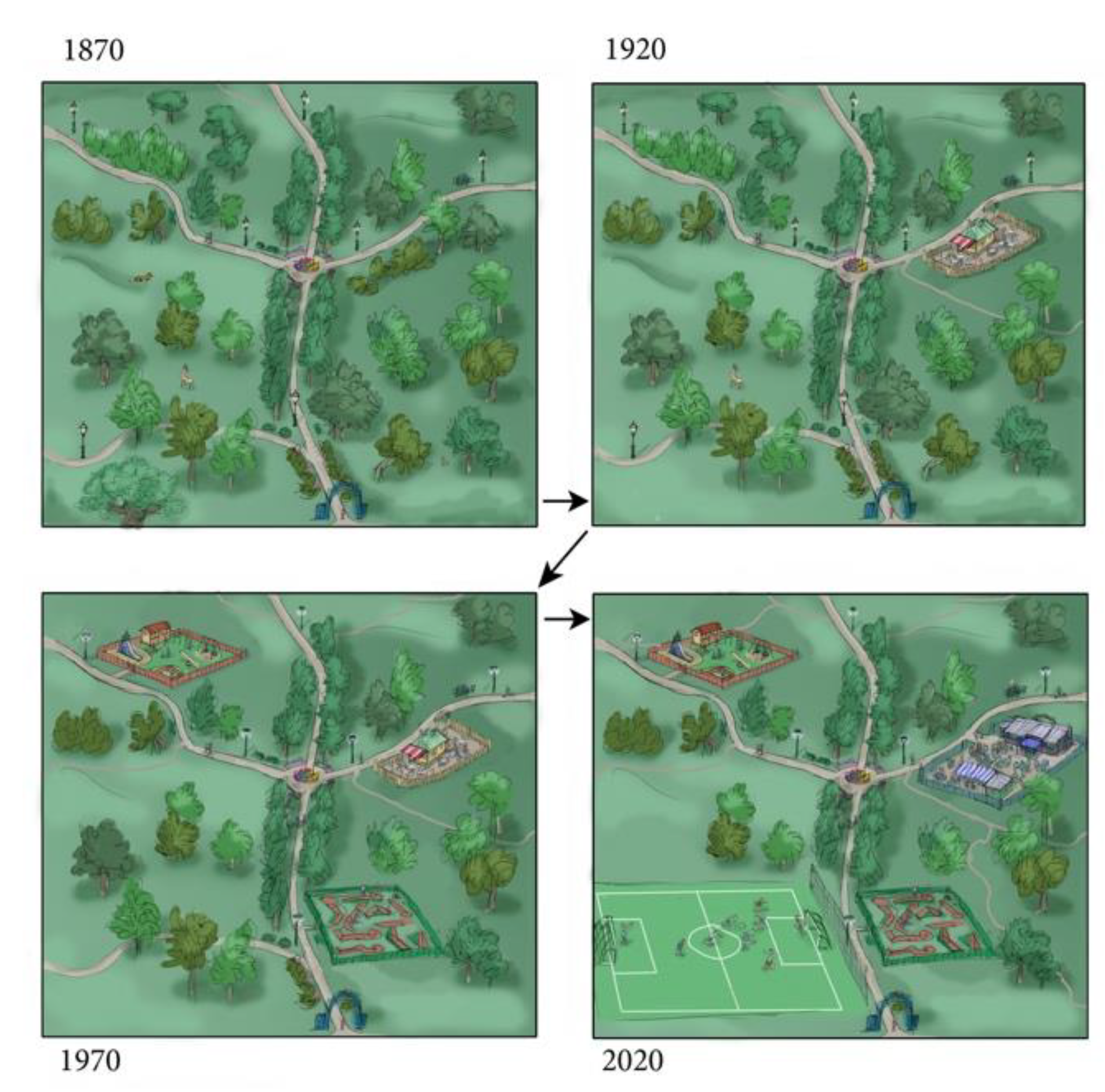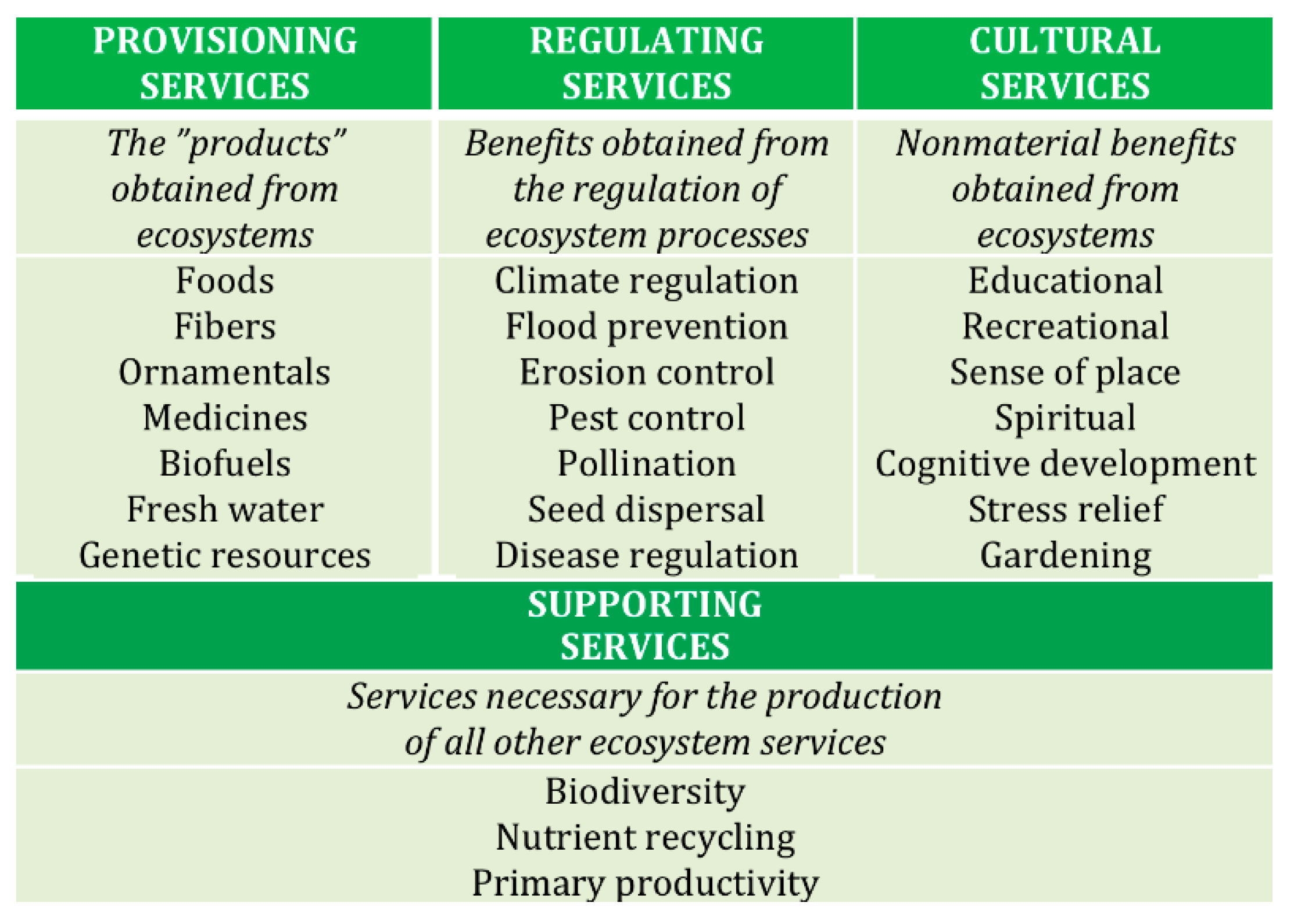The Incremental Demise of Urban Green Spaces
Abstract
1. Introduction
2. Urban Green Space Dynamics and Reasons for Their Incremental Demise
2.1. Lack of Financial Support
2.2. The Separation of Attributes
2.3. Increased Private Control
2.4. Under-Utilization
2.5. Congestion
2.6. Activity Intensification
3. Baseline Shifts and Benefits of Nature
4. Long-Term Resilience Planning
5. Concluding Remarks
Author Contributions
Funding
Acknowledgments
Conflicts of Interest
References
- Fuller, R.A.; Gaston, K.J. The scaling of green space coverage in European cities. Biol. Lett. 2009, 5, 352–355. [Google Scholar] [CrossRef]
- Colding, J. The Role of Ecosystem Services in Contemporary Urban Planning. In Urban Ecology; Oxford University Press: Oxford, UK, 2011; pp. 228–237. [Google Scholar]
- Lee, S.; Webster, C. Enclosure of the urban commons. GeoJournal 2006, 66, 27–42. [Google Scholar] [CrossRef]
- Leclercq, E.; Pojani, D.; Van Bueren, E. Is public space privatization always bad for the public? Mixed evidence from the United Kingdom. Cities 2020, 100, 102649. [Google Scholar] [CrossRef]
- World Health Organization. Urban green spaces: A brief for action. Reg. Off. Eur. 2017. Available online: http://www.euro.who.int/__data/assets/pdf_file/0010/342289/Urban-Green-Spaces_EN_WHO_web3.pdf?ua=1 (accessed on 6 March 2020).
- Kabisch, N.; Haase, D. Green spaces of European cities revisited for 1990–2006. Landsc. Urban Plan. 2013, 110, 113–122. [Google Scholar] [CrossRef]
- Kohn, M. Brave New Neighborhoods; Routledge: Abingdon-on-Thames, UK, 2004; ISBN 9780203495117. [Google Scholar]
- Wirth, L. Urbanism Way of Life. Am. J. Sociol. 1938, 44, 1–24. [Google Scholar] [CrossRef]
- Pasaogullari, N.; Doratli, N. Measuring accessibility and utilization of public spaces in Famagusta. Cities 2004, 21, 225–232. [Google Scholar] [CrossRef]
- Lindholm, G. Land and Landscape; Linking Use, Experience and Property Development in Urban Areas. Land 2019, 8, 137. [Google Scholar] [CrossRef]
- Fahrig, L. Effects of Habitat Fragmentation on Biodiversity. Annu. Rev. Ecol. Evol. Syst. 2003, 34, 487–515. [Google Scholar] [CrossRef]
- Zhou, W.; Wang, J.; Qian, Y.; Pickett, S.T.A.; Li, W.; Han, L. The rapid but “invisible” changes in urban greenspace: A comparative study of nine Chinese cities. Sci. Total Environ. 2018, 627, 1572–1584. [Google Scholar] [CrossRef]
- Ogen, Y. Assessing nitrogen dioxide (NO2) levels as a contributing factor to coronavirus (COVID-19) fatality. Sci. Total Environ. 2020, 726, 138605. [Google Scholar] [CrossRef]
- Samuelsson, K.; Barthel, S.; Colding, J.; Macassa, G.; Giusti, M. Urban Nature as a Source of Resilience during Social Distancing Amidst the Coronavirus Pandemic. OSF Preprint. 2020. Available online: https://osf.io/3wx5a/ (accessed on 6 March 2020). [CrossRef]
- Nilsson, K.L. Managing Complex Spatial Planning Processes. Plan. Theory Pract. 2007, 8, 431–447. [Google Scholar] [CrossRef]
- Ostrom, E. Governing the Commons; Cambridge University Press: Cambridge, UK, 2015; ISBN 9781316423936. [Google Scholar]
- Berkes, F.; Colding, J.; Folke, C. Navigating Social-Ecological Systems; Berkes, F., Colding, J., Folke, C., Eds.; Cambridge University Press: Cambridge, UK, 2001; ISBN 9780521815925. [Google Scholar]
- North, D.C. Institutions, Institutional Change and Economic Performance; Cambridge University Press: Cambridge, UK, 1990; ISBN 9780521397346. [Google Scholar]
- Ostrom, E. Crafting Institutions for Self-Governing Irrigation Systems; ICS Press: San Francisco, CA, USA, 1992; ISBN 9781558151680. [Google Scholar]
- Hanna, S.; Folke, C.; Mäler, K.-G. Property Rights and the Natural Environment. In Rights to Nature: Ecological, Economic, Cultural, and Political Principles of Institutions for the Environment; Island Press: Washington, DC, USA, 1996. [Google Scholar]
- De Sousa Silva, C.; Viegas, I.; Panagopoulos, Τ.; Bell, S. Environmental Justice in Accessibility to Green Infrastructure in Two European Cities. Land 2018, 7, 134. [Google Scholar] [CrossRef]
- Gren, Å.; Andersson, E. Being efficient and green by rethinking the urban-rural divide—Combining urban expansion and food production by integrating an ecosystem service perspective into urban planning. Sustain. Cities Soc. 2018, 40, 75–82. [Google Scholar] [CrossRef]
- Colding, J.; Lundberg, J.; Folke, C. Incorporating Green-area User Groups in Urban Ecosystem Management. AMBIO A J. Hum. Environ. 2006, 35, 237–244. [Google Scholar] [CrossRef] [PubMed]
- McDonald, R.I.; Forman, R.T.T.; Kareiva, P. Open Space Loss and Land Inequality in United States’ Cities, 1990–2000. PLoS ONE 2010, 5, e9509. [Google Scholar] [CrossRef] [PubMed]
- Hirt, S.; Kovachev, A. The changing spatial structure of post-socialist Sofia. In The Urban Mosaic of Post-Socialist Europe. Contributions to Economics; Tsenkova, S., Nedović-Budić, Z., Eds.; Physica-Verlag HD: Heidelber, Germany, 2006; pp. 113–130. [Google Scholar]
- Haase, D.; Kabisch, S.; Haase, A.; Andersson, E.; Banzhaf, E.; Baró, F.; Brenck, M.; Fischer, L.K.; Frantzeskaki, N.; Kabisch, N.; et al. Greening cities—To be socially inclusive? About the alleged paradox of society and ecology in cities. Habitat Int. 2017, 64, 41–48. [Google Scholar] [CrossRef]
- Mensah, C.A. Destruction of Urban Green Spaces: A Problem beyond Urbanization in Kumasi City (Ghana). Am. J. Environ. Prot. 2014, 3, 1–9. [Google Scholar] [CrossRef]
- Jones, R. Managing the green spaces: Problems of maintaining quality in a local government service department. Manag. Serv. Qual. Int. J. 2000, 10, 19–31. [Google Scholar] [CrossRef]
- Heritage Lottery Fund. State of UK Public Parks. 2016. Available online: https://www.heritagefund.org.uk/sites/default/files/media/attachments/state_of_uk_public_parks_2016_final_for_web%281%29.pdf (accessed on 10 March 2020).
- De Magalhães, C.; Freire Trigo, S. Contracting out publicness: The private management of the urban public realm and its implications. Prog. Plan. 2017, 115, 1–28. [Google Scholar] [CrossRef]
- Iossa, E.; Martimort, D. The Simple Microeconomics of Public-Private Partnerships. J. Public Econ. Theory 2015, 17, 4–48. [Google Scholar] [CrossRef]
- Gross, J.S. Business improvement districts in New York: The private sector in public service or the public sector privatized? Urban Res. Pract. 2013, 6, 346–364. [Google Scholar] [CrossRef]
- Anderson, L. A business improvement district for a park? Hey, it just might work. Villager 2008, 78, 14. [Google Scholar]
- Kennedy, D.J. Restraining the Power of Business Improvement Districts: The Case of the Grand Central Partnership. Yale Law Policy Rev. 1996, 15, 283–330. [Google Scholar]
- Colding, J. Creating Incentives for Increased Public Engagement in Ecosystem Management through Urban Commons. In Adapting Institutions; Boyd, E., Folke, C., Eds.; Cambridge University Press: Cambridge, UK, 2011; pp. 101–124. ISBN 9781139017237. [Google Scholar]
- Cybriwsky, R. Changing patterns of urban public space. Cities 1999, 16, 223–231. [Google Scholar] [CrossRef]
- Sparrow, M.K. Managing the Boundary between Public and Private Policing. In Modern Perspectives on Policing: Selected Papers; National Institute of Justice: Washington, DC, USA, 2015; ISBN 9781634639705. [Google Scholar]
- Low, S.M. The Erosion of Public Space and the Public Realm: Paranoia, surveillance and privatization in New York City. City 2006, 18, 43–49. [Google Scholar] [CrossRef]
- Colding, J.; Barthel, S.; Sörqvist, P. Wicked Problems of Smart Cities. Smart Cities 2019, 2, 31. [Google Scholar] [CrossRef]
- Skår, M. Forest dear and forest fear: Dwellers’ relationships to their neighbourhood forest. Landsc. Urban Plan. 2010, 98, 110–116. [Google Scholar] [CrossRef]
- Cervero, R.; Duncan, M. Walking, Bicycling, and Urban Landscapes: Evidence from the San Francisco Bay Area. Am. J. Public Health 2003, 93, 1478–1483. [Google Scholar] [CrossRef]
- Vischer, J.C.; Cranz, G. The Politics of Park Design: A History of Urban Parks in America. Soc. Forces 1984, 63, 287. [Google Scholar] [CrossRef]
- Miller, H.C.; Gratz, R.B.; Mintz, N. Cities Back from the Edge—New Life for Downtown; John Wiley & Sons: Hoboken, NJ, USA, 2000. [Google Scholar]
- Colding, J.; Barthel, S.; Bendt, P.; Snep, R.; van der Knaap, W.; Ernstson, H. Urban green commons: Insights on urban common property systems. Glob. Environ. Chang. 2013, 23, 1039–1051. [Google Scholar] [CrossRef]
- Williams, K.; Burton, E.; Jenks, M. Achieving the Compact City through Intensification: An Acceptable Option? In The Compact City; Burton, E., Jenks, M., Williams, K., Eds.; Spon Press: London, UK, 2010; pp. 71–83. [Google Scholar]
- Haccoû, H.A.; Deelstra, T.; Krośnicka, K.; Dol, M.; Kramer, M. MILU Guide Practitioners’ Handbook for Multifunctional and Intensive Land Use; Habiforum Foundation: Gouda, The Netherlands, 2007; ISBN 978-90-806647-5-3. [Google Scholar]
- Westerink, J.; Haase, D.; Bauer, A.; Ravetz, J.; Jarrige, F.; Aalbers, C.B.E.M. Dealing with Sustainability Trade-Offs of the Compact City in Peri-Urban Planning Across European City Regions. Eur. Plan. Stud. 2013, 21, 473–497. [Google Scholar] [CrossRef]
- Stadsledningskontoret. Grönare Stockholm: Riktlinjer För Planering, Genomförande och Förvaltning av Stadens Parker och Naturområden; Stadsledningskontoret: Stockholm, Sweden, 2016. [Google Scholar]
- Marcus, L.; Colding, J. Toward an integrated theory of spatial morphology and resilient urban systems. Ecol. Soc. 2014, 19, 55. [Google Scholar] [CrossRef]
- Samuelsson, K.; Colding, J.; Barthel, S. Urban resilience at eye level: Spatial analysis of empirically defined experiential landscapes. Landsc. Urban Plan. 2019, 187, 70–80. [Google Scholar] [CrossRef]
- Hartig, T.; Kahn, P.H. Living in cities, naturally. Science 2016, 352, 938–940. [Google Scholar] [CrossRef] [PubMed]
- Miller, J.R. Biodiversity conservation and the extinction of experience. Trends Ecol. Evol. 2005, 20, 430–434. [Google Scholar] [CrossRef]
- Giusti, M.; Barthel, S.; Marcus, L. Nature Routines and Affinity with the Biosphere: A Case Study of Preschool Children in Stockholm. Child. Youth Environ. 2014, 24, 16. [Google Scholar] [CrossRef]
- Barthel, S.; Belton, S.; Raymond, C.M.; Giusti, M. Fostering Children’s Connection to Nature Through Authentic Situations: The Case of Saving Salamanders at School. Front. Psychol. 2018, 9, 928. [Google Scholar] [CrossRef]
- Korah, P.I.; Cobbinah, P.B.; Nunbogu, A.M.; Gyogluu, S. Spatial plans and urban development trajectory in Kumasi, Ghana. GeoJournal 2017, 82, 1113–1134. [Google Scholar] [CrossRef]
- Colding, J.; Barthel, S. The Role of University Campuses in Reconnecting Humans to the Biosphere. Sustainability 2017, 9, 2349. [Google Scholar] [CrossRef]
- Kahn, A.E. The Tyranny of Small Decisions: Market Failures, Imperfections, and the Limits of Economics. Kyklos 1966, 19, 23–47. [Google Scholar] [CrossRef]
- Cooper, C.B.; Dickinson, J.; Phillips, T.; Bonney, R. Citizen Science as a Tool for Conservation in Residential Ecosystems. Ecol. Soc. 2007, 12, 11. [Google Scholar] [CrossRef]
- Ostrom, E. Collective Action and the Evolution of Social Norms. J. Econ. Perspect. 2000, 14, 137–158. [Google Scholar] [CrossRef]
- Ensminger, J. Changing Property Rights: Reconciling Formal and Informal Rights to Land in Africa. In The Frontiers of The New Institutional Economics; Drobak, J.N., Nye, V.C., Eds.; Academic Press: San Diego, CA, USA, 1997; pp. 165–196. [Google Scholar]
- Schumacher, M.; Durán-Díaz, P.; Kurjenoja, A.K.; Gutiérrez-Juárez, E.; González-Rivas, D.A. Evolution and Collapse of Ejidos in Mexico—To What Extent Is Communal Land Used for Urban Development? Land 2019, 8, 146. [Google Scholar] [CrossRef]
- Crépin, A.-S. Complexity, resilience and economics. In Global Challenges, Governance, and Complexity; Galaz, V., Ed.; Edward Elgar Publishing: Cheltenham, UK, 2019; pp. 166–187. [Google Scholar]
- Holling, C.S. Resilience and Stability of Ecological Systems. Annu. Rev. Ecol. Syst. 1973, 4, 1–23. [Google Scholar] [CrossRef]
- Folke, C.; Kofinas, G.P.; Chapin, F.S. Principles of Ecosystem Stewardship; Springer: New York, NY, USA, 2009; ISBN 978-0-387-73032-5. [Google Scholar]
- Schicklinski, J. The Governance of Urban Green Spaces in the EU; Routledge: Abingdon-on-Thames, UK, 2017; ISBN 9781315403823. [Google Scholar]
- Colding, J.; Barthel, S. The potential of ‘Urban Green Commons’ in the resilience building of cities. Ecol. Econ. 2013, 86, 156–166. [Google Scholar] [CrossRef]
- Bendt, P.; Barthel, S.; Colding, J. Civic greening and environmental learning in public-access community gardens in Berlin. Landsc. Urban Plan. 2013, 109, 18–30. [Google Scholar] [CrossRef]
| 1 | By the term ‘social-ecological’ is here meant a set of critical natural, socioeconomic, and cultural resources (or, capitals) whose flow and use is regulated by a combination of ecological and social systems. |


© 2020 by the authors. Licensee MDPI, Basel, Switzerland. This article is an open access article distributed under the terms and conditions of the Creative Commons Attribution (CC BY) license (http://creativecommons.org/licenses/by/4.0/).
Share and Cite
Colding, J.; Gren, Å.; Barthel, S. The Incremental Demise of Urban Green Spaces. Land 2020, 9, 162. https://doi.org/10.3390/land9050162
Colding J, Gren Å, Barthel S. The Incremental Demise of Urban Green Spaces. Land. 2020; 9(5):162. https://doi.org/10.3390/land9050162
Chicago/Turabian StyleColding, Johan, Åsa Gren, and Stephan Barthel. 2020. "The Incremental Demise of Urban Green Spaces" Land 9, no. 5: 162. https://doi.org/10.3390/land9050162
APA StyleColding, J., Gren, Å., & Barthel, S. (2020). The Incremental Demise of Urban Green Spaces. Land, 9(5), 162. https://doi.org/10.3390/land9050162






